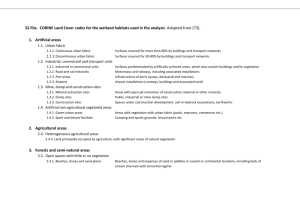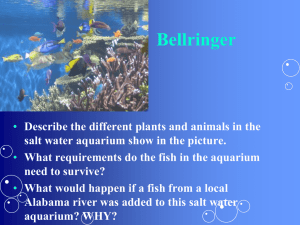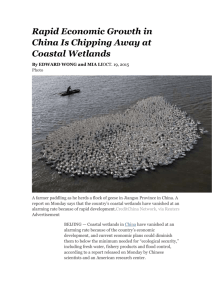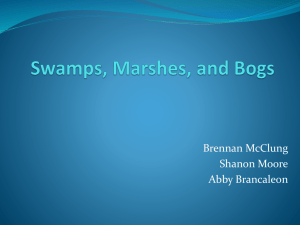California`s Coastal Wetlands
advertisement
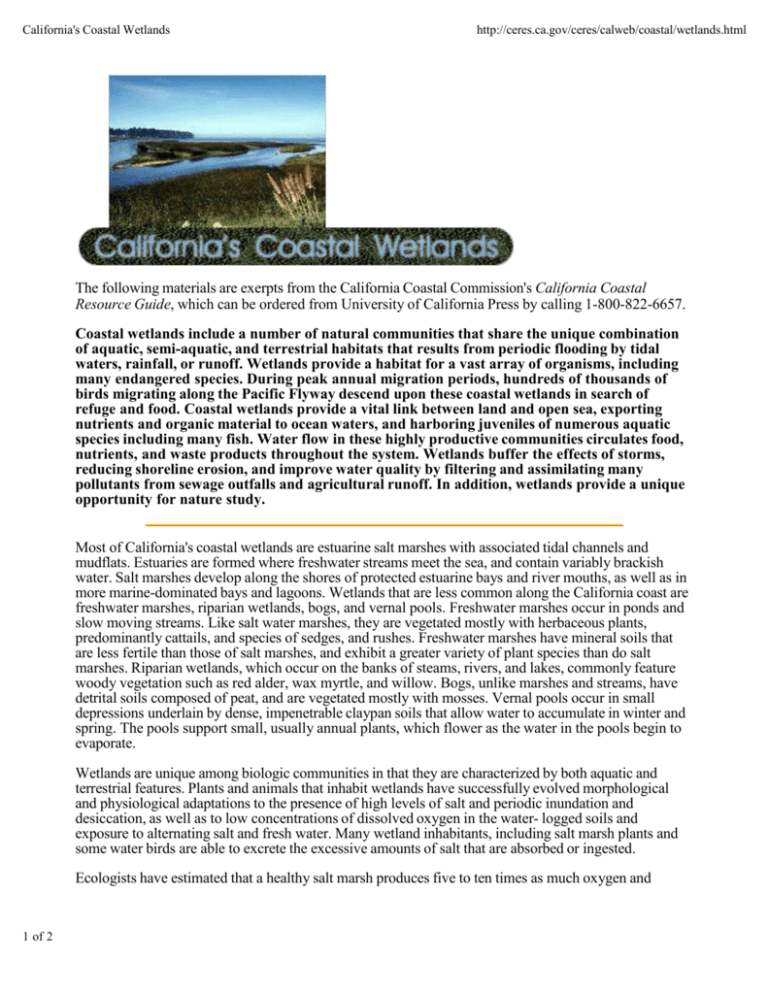
California's Coastal Wetlands http://ceres.ca.gov/ceres/calweb/coastal/wetlands.html The following materials are exerpts from the California Coastal Commission's California Coastal Resource Guide, which can be ordered from University of California Press by calling 1-800-822-6657. Coastal wetlands include a number of natural communities that share the unique combination of aquatic, semi-aquatic, and terrestrial habitats that results from periodic flooding by tidal waters, rainfall, or runoff. Wetlands provide a habitat for a vast array of organisms, including many endangered species. During peak annual migration periods, hundreds of thousands of birds migrating along the Pacific Flyway descend upon these coastal wetlands in search of refuge and food. Coastal wetlands provide a vital link between land and open sea, exporting nutrients and organic material to ocean waters, and harboring juveniles of numerous aquatic species including many fish. Water flow in these highly productive communities circulates food, nutrients, and waste products throughout the system. Wetlands buffer the effects of storms, reducing shoreline erosion, and improve water quality by filtering and assimilating many pollutants from sewage outfalls and agricultural runoff. In addition, wetlands provide a unique opportunity for nature study. Most of California's coastal wetlands are estuarine salt marshes with associated tidal channels and mudflats. Estuaries are formed where freshwater streams meet the sea, and contain variably brackish water. Salt marshes develop along the shores of protected estuarine bays and river mouths, as well as in more marine-dominated bays and lagoons. Wetlands that are less common along the California coast are freshwater marshes, riparian wetlands, bogs, and vernal pools. Freshwater marshes occur in ponds and slow moving streams. Like salt water marshes, they are vegetated mostly with herbaceous plants, predominantly cattails, and species of sedges, and rushes. Freshwater marshes have mineral soils that are less fertile than those of salt marshes, and exhibit a greater variety of plant species than do salt marshes. Riparian wetlands, which occur on the banks of steams, rivers, and lakes, commonly feature woody vegetation such as red alder, wax myrtle, and willow. Bogs, unlike marshes and streams, have detrital soils composed of peat, and are vegetated mostly with mosses. Vernal pools occur in small depressions underlain by dense, impenetrable claypan soils that allow water to accumulate in winter and spring. The pools support small, usually annual plants, which flower as the water in the pools begin to evaporate. Wetlands are unique among biologic communities in that they are characterized by both aquatic and terrestrial features. Plants and animals that inhabit wetlands have successfully evolved morphological and physiological adaptations to the presence of high levels of salt and periodic inundation and desiccation, as well as to low concentrations of dissolved oxygen in the water- logged soils and exposure to alternating salt and fresh water. Many wetland inhabitants, including salt marsh plants and some water birds are able to excrete the excessive amounts of salt that are absorbed or ingested. Ecologists have estimated that a healthy salt marsh produces five to ten times as much oxygen and 1 of 2 California's Coastal Wetlands http://ceres.ca.gov/ceres/calweb/coastal/wetlands.html corresponding carbohydrate biomass per acre as a wheat field. Marsh plants capture the energy of sunlight and form the basis the highly productive wetland food web. A key part of the wetlands success is the breakdown of plant matter into detritus, which is then consumed by filter feeders, deposit feeders, and other omnivores and scavengers. This assemblage of producers and consumers creates a large food web, with fish, birds, and humans as ultimate links. Decomposers, such as bacteria and fungi, also break down plant and animal matter and recycle the nutrients. Excrement from birds, fish, and invertebrates further enhances marsh soils and waters with nitrogen rich compounds, which are taken up by algae and vascular plants. These materials are transported and mixed by streamflows, tidal circulation, and even the activities of burrowing clams and shrimp. As a result, the mudflats become rich in inorganic nutrients and organic foods. This "mixing bowl" helps to support the many links of the marsh's food chains. Salt marsh food webs are among the most complex in nature. Coastal wetlands are home to a variety of animals. Numerous fish species, including California killifish, bay goby, striped bass, topsmelt, and starry flounder are residents of wetlands and depend upon them for reproduction. Subtidal eelgrass beds shelter larval and juvenile fish, as well as many species of invertebrates. Salt marshes are home to insects such as the salt marsh water boatman, wandering skipper, and numerous species of beetles and flies, which graze on leave and seeds, help to pollinate the wetland flowers, and prey upon a variety of small animals. Clapper rails build platform nests in the low marsh, whereas Belding's savannah sparrows nest in and feed on the pickleweed of the higher marsh. Salt marsh mammals include shrews, harvest mice, and other rodents; harbor seals haul out on pickleweed and saltgrass in south San Francisco Bay. Although relatively few bird species are year-round residents of coastal wetlands, many species temporarily inhabit salt marshes during their annual migrations. Coastal California is part of the Pacific Flyway, one of the four principal bird migration routes in North America. During the spring and fall months, coastal wetlands support flocks of waterfowl such as brant, pintails, mallard, and canvasbacks, and shorebirds such as sandpipers, curlews, willets, and godwits, which stop here to rest, feed, and in some cases overwinter. Since the 1850's 90 per cent of California's original coastal wetland acreage has disappeared, and many of the remaining wetlands are in danger of being further degraded or destroyed due to landfill, diking, dredging, pollution, and other human disturbances. However, a growing awareness of the importance of this habitat has led to efforts to protect existing wetlands, and to restore those that have been degraded. | Search | Comment | Natural Resources | Coastal Resources | Coastal Geography | 2 of 2
